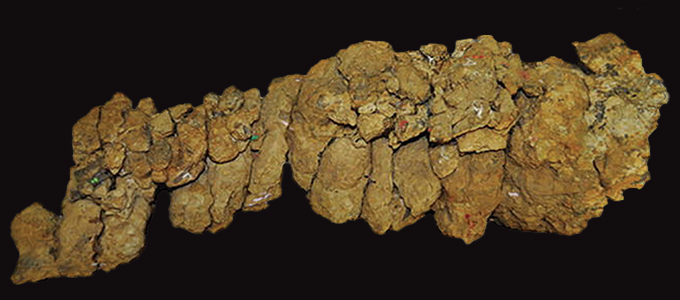Physical Address
304 North Cardinal St.
Dorchester Center, MA 02124
Physical Address
304 North Cardinal St.
Dorchester Center, MA 02124

Scientists have made a groundbreaking discovery in the field of paleontology and archaeology. Neutrons, subatomic particles, are being used to unveil hidden secrets of fossils and artifacts, providing researchers with unprecedented insights into the past.
One of the key causes behind this breakthrough is the limitations of traditional imaging techniques. X-rays, which have been widely used in the field, have their limitations when it comes to dense materials or low-density objects. Iron-rich stone, for example, can block out X-rays, making it difficult to obtain a clear image of the fossil or artifact.
This is where neutrons come into play. Unlike X-rays, neutrons have no electric charge and can pass through dense materials like lead, iron, and copper. They interact with the nuclei of atoms, providing a different perspective on the object being scanned.
Neutron scans have revealed intricate details that were previously hidden from view. In the case of a crocodile fossil, neutron scans uncovered the remains of a dinosaur inside its belly. This discovery offers a unique snapshot of life during the Cretaceous Period, providing valuable insights into the predator-prey relationships of that time.
The use of neutrons in imaging ancient objects is not a recent development. Neutrons were discovered in 1932, and since then, they have been used in various fields, including manufacturing and military equipment. However, their application in paleontology and archaeology has gained traction only in recent years.
One of the reasons for this is the availability of neutron imaging facilities. Currently, there are only a few dozen neutron-imaging facilities worldwide, and they require large particle accelerators or nuclear reactors to generate the neutrons. These facilities are costly to operate and require extensive oversight to ensure safety.
Despite these challenges, the use of neutron scans in paleontology and archaeology is growing. Researchers are increasingly taking advantage of the unique capabilities of neutrons to peer inside fossils and artifacts without causing damage. Neutron scans have helped study mummified animals, ancient vertebrate hearts, and even detect signs of recently applied glues on ancient artifacts.
However, it is important to note that neutron imaging is not without its risks. Neutron beams can make objects radioactive, and the level of radioactivity can last for days to weeks after the scan. This poses challenges in handling and displaying the scanned objects, especially when dealing with valuable and delicate artifacts.
Nonetheless, the use of neutrons in uncovering hidden secrets of fossils and artifacts marks a significant advancement in the field of paleontology and archaeology. It offers researchers a new window into the past, providing insights that were previously inaccessible. With further advancements in technology and the expansion of neutron imaging facilities, we can expect even more remarkable discoveries in the future.
The use of neutron imaging in paleontology and archaeology has had a profound impact on the field, revolutionizing our understanding of fossils and artifacts. This powerful technique has led to a range of significant effects, enhancing our knowledge of the past and opening up new avenues of research.
One of the key effects of neutron imaging is the ability to uncover hidden details within fossils and artifacts. By utilizing neutrons, researchers have been able to see through dense materials and low-density objects, revealing intricate structures and preserved remains that were previously inaccessible. This has allowed for more accurate and comprehensive analyses of ancient specimens.
Neutron imaging has also provided unprecedented insights into predator-prey relationships and ancient ecosystems. The discovery of a dinosaur inside the belly of a crocodile fossil, made possible through neutron scans, offers a unique snapshot of life during the Cretaceous Period. This finding sheds light on the interactions between different species and provides valuable information about the dynamics of ancient ecosystems.
Furthermore, neutron imaging has played a crucial role in the preservation and study of delicate artifacts. By avoiding the need for physical extraction or invasive procedures, neutron scans have allowed researchers to examine objects without causing damage. This non-destructive approach has been particularly valuable in the study of mummified animals, ancient textiles, and fragile artifacts, preserving their integrity for future generations.
The use of neutron imaging has also contributed to the detection of fraudulent practices in the antiquities market. By analyzing the composition and structure of artifacts, neutron scans can reveal signs of recently applied glues or other alterations. This has helped in identifying fake or manipulated objects, ensuring the authenticity and integrity of cultural heritage.
Moreover, the availability of neutron imaging facilities has sparked collaborations and knowledge-sharing among researchers worldwide. The limited number of these facilities has created a network of experts who exchange ideas, techniques, and findings. This collaborative environment has accelerated advancements in the field and fostered a deeper understanding of the past.
Overall, the effect of neutron imaging on paleontology and archaeology has been transformative. It has expanded our understanding of ancient life, provided new insights into ecosystems and predator-prey relationships, preserved delicate artifacts, detected fraud in the antiquities market, and fostered global collaboration. As technology continues to advance and more researchers embrace neutron imaging, we can expect even more remarkable discoveries and a deeper understanding of our shared history.
If you’re wondering where the article came from!
#